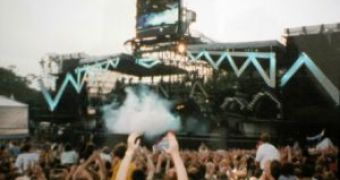When you look at a 1 or 2 hours concert, you should know that more than 12 hours are needed to the mounting made by hundreds of specialists. Let's see the technical components behind a concert:
Sound power: The big concerts use clusters or rows of baffles of 4, 6 or 8 of speakers.
They are mounted in towers on both sides of the scene in the lower part. They reach till 250,000 sound watts.
Light power: The light show is equal to the sound: 300,000 light watts, which astonish with its variety. The numbers of some concerts are eloquent: 500 static lights, 170 varilite light, 80 icons, filters with more than 70 colors in the stroboscopic lights, and so on.
The screen: It may reach 10 m (30 feet) in diameter. This way, the public can watch what's happening on the scene. Moreover, it can complete the show with many types of video clips or projections.
The montage: After setting the basic frame, the light console tables are installed. After that, the sound equipments are installed. The whole process lasts 12 and a half hours.
The scene: Its dimensions vary greatly. The height oscillates between 5 and 25 m (15 to 75 feet), depending on the light. This is an engineering piece of work: it may spin, hide in smoke flying platforms, telescopic bridges, crane, and so on.
Control: The neuralgic center of the concert is situated in the so called "house", where illumination and sound are tuned through an expanded computerized control table, fundamental for the sound to reach perfectly all the public.
Cables and supply: In order to avoid energy cuts during the concert, two or more tree-phase generators of 500 kW each are used. A hose, called snake, connects the central console table with the scene. Almost 8 km of cable are employed.
Trailers and transport: The caravans of trailers, buses, private cars and vans are the identity marks of big tours. Big concerts move more than 50 trucks and 350 material tones.
Dressing rooms: Behind the scene, a small complex is hidden, including dressing rooms, dining room, a rest room, a make-up room, and other "demands" of the artists.

 14 DAY TRIAL //
14 DAY TRIAL //